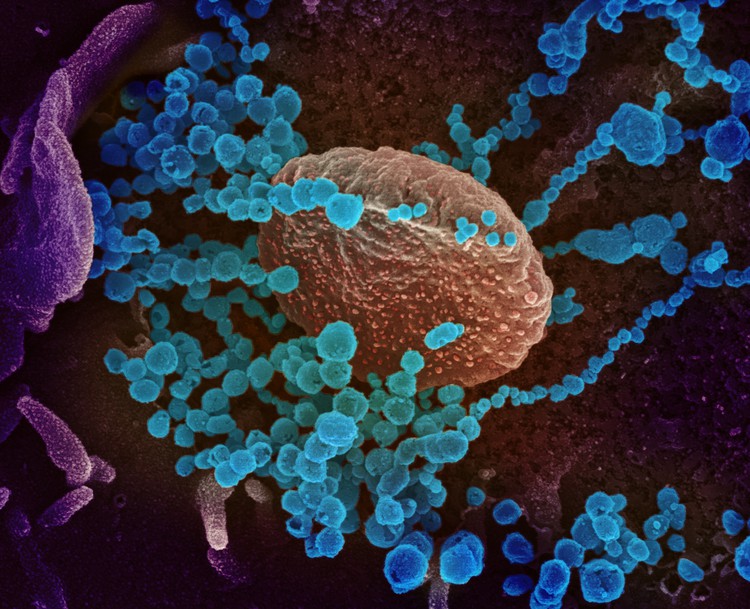
Researchers have estimated using Chinese and Italian data how many South Africans could die of Covid-19.
(Image of SARS-CoV-2 virions emerging from a cell by the US NIAID, CC BY 2.0)
29 March 2020
How many people could Covid-19 kill in South Africa? Researchers at the University of East Anglia in England have used data from the Chinese and Italian epidemics to make an online tool that estimates the potential number of deaths in other countries, including South Africa.
Led by Professor Peter Lloyd-Sherlock, the team, known as the Potential Impact of COVID-19 on Human Mortality (PIHCM) Expert Consortium, warns that the tool’s results should be treated with caution. They have made assumptions based on the very imperfect knowledge we have of the coronavirus pandemic. Scientists are still unsure of how fast the virus spreads and what percentage of infected people it kills.
The interesting thing about this tool though is that it takes into account the ages of a country’s population. Here are the estimates for South Africa assuming that 25% or 50% of the population gets infected, using the Italian or Chinese mortality data:
|
Data from |
% infected |
Total |
Age: 0-29 |
30-39 |
40-49 |
50-59 |
60-69 |
70-79 |
80+ |
|
China |
25 |
119,798 |
9,643 |
5,985 |
7,349 |
15,351 |
28,392 |
30,811 |
22,267 |
|
China |
50 |
239,610 |
19,287 |
11,973 |
14,699 |
30,705 |
56,785 |
61,623 |
44,538 |
|
Italy |
25 |
94,835 |
0 |
3,086 |
1,090 |
6,673 |
21,174 |
37,212 |
25,590 |
|
Italy |
50 |
189,638 |
0 |
6,170 |
2,176 |
13,343 |
42,347 |
74,423 |
51,179 |
For example if 50% of the population gets infected then using the Chinese data nearly 240,000 people in South Africa would die, and using the Italian data about 190,000 South Africans would die. Halve these numbers if we keep infections to 25%.
Peter Lloyd-Sherlock told GroundUp: “These are just hypothetical scenarios, based on a best-guess approach. What we can’t guess is how well South Africans will respond to this calamity. Quite simple actions could do a lot to limit the rate of infection, potentially saving many thousands of lives.”
These calculations do not take into account that South Africans are generally in poorer health than the Italian and Chinese populations. It is unknown if the higher rates of HIV, TB, diabetes, and hypertension and the poorer nutritional status of many people will result in a higher death rate. And while the intensive care units in facilities like Groote Schuur Hospital are first-class, most cities and towns in South Africa cannot offer the kind of care that is being offered in Italy, nor even China probably.
To understand what it means for 240,000 people to die, consider that about 60,000 South Africans are expected to die of AIDS in 2020 (source: Thembisa model). In the worst year of the AIDS epidemic, 2005, about 285,000 people died of the disease, an average of nearly 770 people per day. So we’d be looking at the kind of mortality we had in 2005.
This is bad enough, but it will be a lot worse if much more than 50% of people get infected (which is possible if the virus is allowed to spread without efforts to stop it) or our population’s poor health results in more deaths.
And there is a further factor that can make it even worse. Even at the height of the AIDS crisis, deaths were spread out more or less evenly in a year. But here if the curve is not flattened (in other words, if we do not act to slow the number of infections), most of these deaths would happen over a few months, with immediate and devastating effects on the health system and on patients who don’t have Covid-19. Also many people who survive Covid-19 nevertheless become very ill and also need to go to hospital. If the health system cannot cope, people who could have survived the illness may die.
It is because of scenarios like this that governments across the world, including South Africa, are taking strenuous action to reduce the rate of infections.
Professor Francois Venter, a director at Wits University’s Ezintsha research unit, said this analysis gives South Africa a “heads-up”. He said we have the resources to intervene and keep the infection rate down. “We cannot behave like the US and stick our heads in the sand. We need to support the lockdown and case finding urgently.”
GroundUp’s policy is that we prefer not to report on medical research that has not been peer-reviewed, such as this. But we are making cautious exceptions during the Covid-19 crisis.